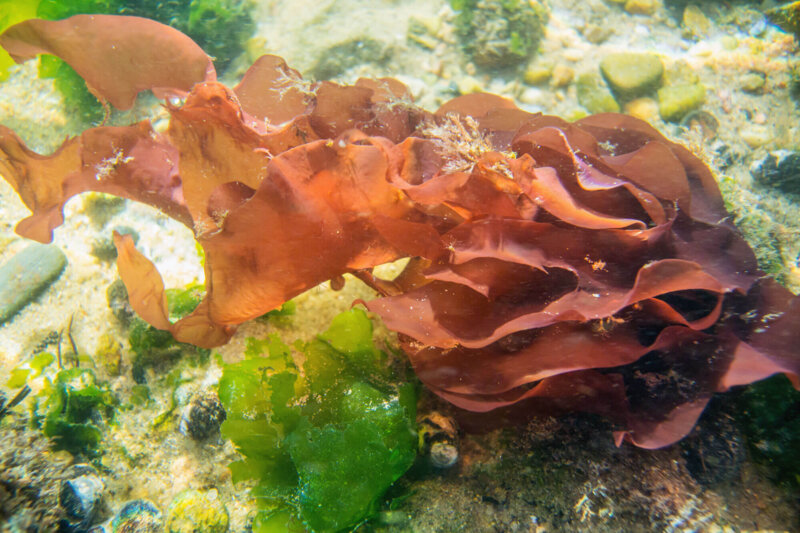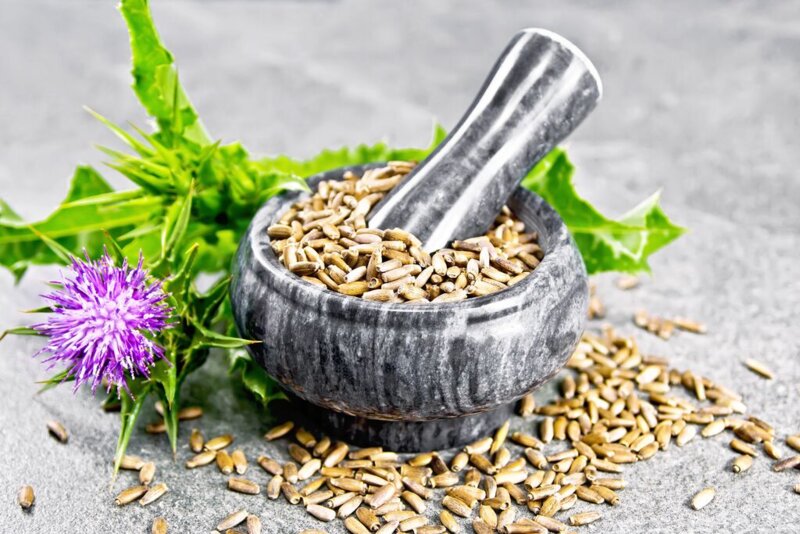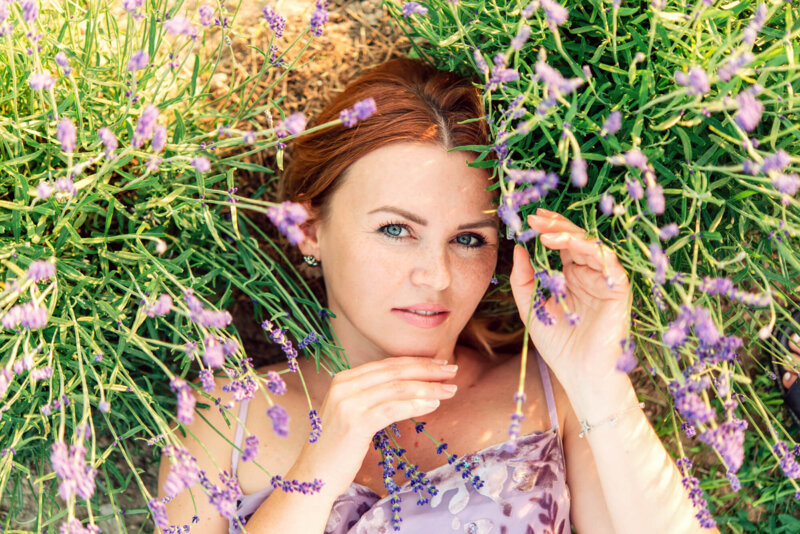- protects the skin
- supports the immune system
- for muscles, tendons, ligaments and joints
Astaxanthin – the power antioxidant from nature

Astaxanthin is considered the strongest known natural antioxidant in the world. Antioxidants are vital substances that protect the body from harmful influences. Thanks to its cell-protecting properties, astaxanthin can have positive effects on the immune system, the cardiovascular system, the eyes, the skin, brain functions and cell ageing.
Astaxanthin - 100% naturally occurring antioxidant
Astaxanthin belongs to the group of carotenoids. As naturally occurring antioxidants, they give many fruits and vegetables their red, yellow or orange colour (Spectrum, 2023). Astaxanthin is a red colour pigment that is produced by microalgae such as blood rain algae. The blood rain algae, also known as Haematococcus pluvialis, is normally green in colour. When it is stressed, for example by strong sunlight, a lack of nutrients or water, it produces large quantities of astaxanthin. As a result, it changes colour from green to red and is protected from harmful influences. With the help of astaxanthin, it can survive for many weeks without nutrients or water (Windisch, 2021).
Astaxanthin protects the cells
Astaxanthin is considered to be one of the most powerful antioxidants found in nature. It is even described as the strongest antioxidant in the world. Its effectiveness dwarfs that of all known antioxidants. Studies have shown that it is 6,000 times more powerful than vitamin C and 100 times more powerful than vitamin E (Nishida, 2007).
Antioxidants protect the body from so-called "free radicals". These are produced during various metabolic processes in the body. On the other hand, they are also caused by harmful external influences such as cigarette smoke, UV radiation, environmental toxins or stress. Free radicals change the cells, can damage the genetic material and are involved in the ageing process (Doccheck Flexikon, 2023). If there are too many free radicals in the body, so-called "oxidative stress" occurs. Oxidative stress can cause damage to body cells. It presumably also plays a role in the development of various health problems (Doccheck Flexikon, 2023). It also causes the skin to age more quickly (Consumer advice centre, 2023). Antioxidants, on the other hand, are true miracle cures; they help the body fight free radicals by scavenging them and rendering them harmless. In doing so, they can protect the body's own cells from premature ageing.
Not all astaxanthin is the same
In addition to naturally obtained astaxanthin from microalgae, there is also synthetically produced astaxanthin. However, studies have shown that natural astaxanthin is far superior to synthetically produced astaxanthin. Its ability to neutralise free radicals is 20 times higher than that of synthetically produced astaxanthin (Capelli, 2013).
Astaxanthin - the all-rounder
Astaxanthin is a real powerhouse with a wide range of health benefits. It is a highly effective cell protector that supports the skin, eyes, cardiovascular system, immune system, muscles, ligaments and tendons as well as the brain and nervous system. These many different health effects are due to its protection against oxidative stress. As a powerful antioxidant, astaxanthin can prevent oxidative stress in the body (Donoso, 2021) and thus have an impact on various areas of the body.
1. Astaxanthin protects the skin
As the human body's outer protective shield, the skin is constantly exposed to environmental influences such as UV radiation, heat, cold, environmental toxins and much more. As a result, it has to cope with a particularly high level of free radicals and oxidative stress. This damages the cells and ages the skin. Due to its antioxidant properties, astaxanthin can protect the skin from UV-induced damage (Ito, 2018; Donoso, 2021). It also improves the skin's moisture content and elasticity (Ito 2018; Zhou, 2021; Tominaga, 2012; Yamashita, 2006; Phetcharat, 2015). Clinical studies have shown that astaxanthin can demonstrably reduce the depth of wrinkles (Tominaga, 2012; Yamashita, 2006; Tominaga, 2017; Zhou, 2021; Phetcharat, 2015) and protect the skin against ageing processes (Zhou, 2021).
2. Astaxanthin supports the immune system
Astaxanthin has a positive effect on the immune system. It supports this by increasing the number and activity of various immune cells. At the same time, it is able to reduce oxidative stress in the body (Park, 2010; Baralic, 2015).
3. Astaxanthin - for muscles, tendons, ligaments and joints
Exercise can increase lactate levels in the muscles, which can cause fatigue and a burning sensation in the muscles. Astaxanthin can lower lactate levels and thus support muscle function (Sawaki, 2002; Wu, 2019).
Astaxanthin protects against the formation of free radicals during exercise and can therefore reduce muscle damage (Wu, 2019; Djordjevic, 2012). It can also improve muscle endurance, strength (Malmsten, 2009), flexibility (Baralic, 2015) and recovery after exercise.
Astaxanthin can also accelerate the improvement of symptoms caused by overuse during sport. One study showed that the symptoms of tennis elbow improved more quickly after taking astaxanthin (Spiller, 2006).
There is also initial promising evidence from animal studies suggesting that astaxanthin has a positive effect on joints (Sun, 2019; Kumar, 2020; Park, 2020).
4. Astaxanthin supports cardiovascular health
Astaxanthin protects the heart in various ways: Astaxanthin is able to lower blood lipid levels. It also reduces bad cholesterol (LDL) and increases good cholesterol (HDL) in the blood (Yoshida, 2010). Studies also suggest that astaxanthin can lower blood pressure (Mashhadi, 2018).
5. Astaxanthin helps to maintain vision
New studies assume that oxidative stress also plays a role in the development of vision problems (Donoso, 2021). Clinical studies show that astaxanthin improves blood circulation in the eye and is therefore important for maintaining vision (Donoso, 2021; Nagaki, 2005; Saito, 2012). In addition, astaxanthin can improve accommodation, i.e. the change between near and far vision of the eyes (Nagaki, 2002) and counteract eye fatigue (Sawaki, 2002).
6. Astaxanthin - good for the brain
There is evidence that astaxanthin may be important for maintaining and supporting brain function. In one study, astaxanthin improved memory performance in people who complained of forgetfulness (Katagiri, 2012). In another study, astaxanthin was able to reduce the amount of toxins in the brain (Nakagawa, 2011).
Astaxanthin – the power vital substance
- supports cardiovascular health
- helps to maintain eyesight
- good for the brain
Sources
Spektrum. Lexikon der Biologie. Carotinoide. https://www.spektrum.de/lexikon/biologie/carotinoide/12331. Abgerufen am 26.1.2023.
Windisch J. Wachstum verschiedener H. pluvialis Stämme in unterschiedlichen Nährmedien und Entwicklung einer neuen Analyse zur Bestimmung des Astaxanthin-Gehaltes. Bachelorarbeit 2021. https://digitalcollection.zhaw.ch/bitstream/11475/24306/1/2021_Windisch_Jonas_BA_UI.pdf. Abgerufen am 30.01.2023
Nishida Y, Yamashita E, Miki W. Quenching activities of common hydrophilic and lipophilic antioxidants against singlet oxygen using chemiluminescence detection system. Carotenoid Science. 2007;11: 16–20. https://www.researchgate.net/publication/285255302_Quenching_activities_of_common_hydrophilic_and_lipophilic_antioxidants_against_singlet_oxygen_using_chemiluminescence_detection_system.
DocCheck Flexikon. Oxidativer Stress. https://flexikon.doccheck.com/de/Oxidativer_Stress. Abgerufen am 31.01.2023.
Verbraucherzentrale. Antioxidantien: Helfer gegen freie Radikale. https://www.verbraucherzentrale.de/wissen/lebensmittel/nahrungsergaenzungsmittel/antioxidantien-helfer-gegen-freie-radikale-10575 . Abgerufen am 30.01.2023.
Capelli B, Bagchi D, Cysewski G. Synthetic Astaxanthin is significantly inferior to algal-based Astaxanthin as an antioxidant and may not be suitable as a human nutritional supplement. NutraFoods. 2013;12: 145–52. https://link.springer.com/article/10.1007/s13749-013-0051-5
Donoso A, González-Durán J, Muñoz AA, González PA, Agurto-Muñoz C. "Therapeutic uses of natural astaxanthin: An evidence-based review focused on human clinical trials". Pharmacol Res. 2021;166: 105479. https://pubmed.ncbi.nlm.nih.gov/33549728/
Ito N, Seki S, Ueda F. The protective role of astaxanthin for UV-induced skin deterioration in healthy people – a randomized, double-blind, placebo-controlled trial. Nutrients. 2018;10(7): 817. https://pubmed.ncbi.nlm.nih.gov/29941810/
Zhou X, Cao Q, Orfila C, Zhao J, Zhang L. Systematic Review and Meta-Analysis on the Effects of Astaxanthin on Human Skin Ageing. Nutrients. 2021;13(9):2917. https://pubmed.ncbi.nlm.nih.gov/34578794/
Tominaga K, Hongo N, Karato M, Yamashita E. Cosmetic benefits of astaxanthin on humans subjects. Acta Biochim Pol. 2012;59(1):43-47. https://pubmed.ncbi.nlm.nih.gov/22428137/
Yamashita, E. The effects of a dietary supplement containing astaxanthin on skin condition. Food Style 2006;9:72. https://www.semanticscholar.org/paper/VOLUME-10-(2006)-The-Effects-of-a-Dietary-on-Skin-Yamashita/7233e555c54814b272b0a0df12b594b316abe6f3
Phetcharat L, Wongsuphasawat K, Winther K. The effectiveness of a standardized rose hip powder, containing seeds and shells of Rosa canina, on cell longevity, skin wrinkles, moisture, and elasticity. Clin Interv Aging. 2015;10:1849-1856. https://pubmed.ncbi.nlm.nih.gov/26604725/
Tominaga K, Hongo N, Fujishita M, Takahashi Y, Adachi Y. Protective effects of astaxanthin on skin deterioration. J Clin Biochem Nutr. 2017;61, 33–39. https://pubmed.ncbi.nlm.nih.gov/28751807/
Park JS, Chyun JH, Kim YK, Line LL, Chew BP. Astaxanthin decreased oxidative stress and inflammation and enhanced immune response in humans. Nutr Metab (Lond). 2010;7:18. https://pubmed.ncbi.nlm.nih.gov/20205737/
Baralic I, Andjelkovic M, Djordjevic B, et al. Effect of Astaxanthin Supplementation on Salivary IgA, Oxidative Stress, and Inflammation in Young Soccer Players. Evid Based Complement Alternat Med. 2015;2015:783761. https://pubmed.ncbi.nlm.nih.gov/26167194/
Sawaki K, et al. Sports performance benefits from taking natural astaxanthin characterized by visual acuity and muscle fatigue improvements in humans. Journal of Clinical Therapeutics & Medicines 2002;18:(9)73-88. https://www.semanticscholar.org/paper/Sports-Performance-Benefits-from-Taking-Natural-*-Sawaki-Yoshigi/070cb91945b590ce450294a3c2c096d38d2c402f
Wu L, Sun Z, Chen A, Guo X, Wang J. Effect of astaxanthin and exercise on antioxidant capacity of human body, blood lactic acid and blood uric acid metabolism. Sci Sport. 2019;34(5):348–352, 2019. https://www.sciencedirect.com/science/article/abs/pii/S0765159719300322
Djordjevic B, Baralic I, Kotur-Stevuljevic J, et al. Effect of astaxanthin supplementation on muscle damage and oxidative stress markers in elite young soccer players. J Sports Med Phys Fitness. 2012;52(4):382-392. https://pubmed.ncbi.nlm.nih.gov/22828460/
Malmsten CL, Lignell A. Dietary supplementation with astaxanthin-rich algal meal improves strength endurance- a double blind placebo controlled study on male students. Carotenoid Sci. 2009;13:20-22. Malmsten_2009
Baralic I, Andjelkovic M, Djordjevic B, et al. Effect of Astaxanthin Supplementation on Salivary IgA, Oxidative Stress, and Inflammation in Young Soccer Players. Evid Based Complement Alternat Med. 2015;2015:783761. https://pubmed.ncbi.nlm.nih.gov/26167194/
Spiller G, et al. Effect of daily use of natural astaxanthin on symptoms associated with Tennis Elbow (lateral humeral epicondylitis). 2006. Unpublished.
Sun K, Luo J, Jing X, et al. Astaxanthin protects against osteoarthritis via Nrf2: a guardian of cartilage homeostasis. Aging (Albany NY). 2019;11(22):10513-10531. https://pubmed.ncbi.nlm.nih.gov/26167194/
Kumar A, Dhaliwal N, Dhaliwal J, Dharavath RN, Chopra K. Astaxanthin attenuates oxidative stress and inflammatory responses in complete Freund-adjuvant-induced arthritis in rats. Pharmacol Rep. 2020;72(1):104-114. https://pubmed.ncbi.nlm.nih.gov/32016833/
Mashhadi NS, Zakerkish M, Mohammadiasl J, Zarei M, Mohammadshahi M, Haghighizadeh MH. Astaxanthin improves glucose metabolism and reduces blood pressure in patients with type 2 diabetes mellitus. Asia Pac J Clin Nutr. 2018;27(2):341-346. https://pubmed.ncbi.nlm.nih.gov/29384321/
Yoshida H, Yanai H, Ito K, et al. Administration of natural astaxanthin increases serum HDL-cholesterol and adiponectin in subjects with mild hyperlipidemia. Atherosclerosis. 2010;209:520–523. https://pubmed.ncbi.nlm.nih.gov/19892350/
Nagaki Y, Hayasaka S, Yamajda T, Hayasaka Y, Sanada M, Uonomi T. Effects of astaxanthin on accommodation, critical flicker fusion, and pattern visual evoked potential in visual display terminal workers. J Trad Med. 2002;19. https://www.semanticscholar.org/paper/Effects-of-astaxanthin-on-accommodation%2C-critical-Nagaki-Hayasaka/13bf024ccc9a07f88a36046d7d730d808c9fa37c
Nagaki Y, Mihara M, Takahashi J, et al. The effect of astaxanthin on retinal capillary blood flow in normal volunteers, Transl J Clin Ther Med. 2005;21(5). https://www.semanticscholar.org/paper/The-Effect-of-Astaxanthin-on-Retinal-Capillary-Flow-Yasunori-Miharu/1cfacec07fce0dc0870b366a59ca8028c0e51cb2
Saito M, Yoshida K, Saito W, et al. Astaxanthin increases choroidal blood flow velocity. Graefe’s Arch Clin Exp Ophthalmol. 2012;250(2):239–245. https://pubmed.ncbi.nlm.nih.gov/22072378/
Katagiri M, Satoh A, Tsuji S, Shirasawa T. Effects of astaxanthin-rich Haematococcus pluvialis extract on cognitive function: a randomised, double-blind, placebo-controlled study. J Clin Biochem Nutr. 2012;51(2):102-107. https://pubmed.ncbi.nlm.nih.gov/22962526/
Nakagawa K, Kiko T, Miyazawa T, et al. Antioxidant effect of astaxanthin on phospholipid peroxidation in human erythrocytes. Br J Nutr. 2011;105(11):1563-1571. https://pubmed.ncbi.nlm.nih.gov/21276280/









